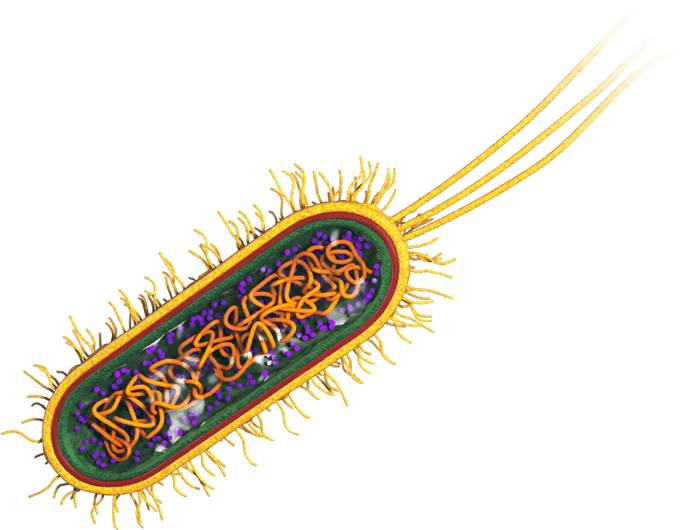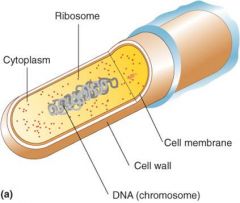40 bacterial cell without labels
Bacterial cell structure - Wikipedia The cell envelope is composed of the cell membrane and the cell wall.As in other organisms, the bacterial cell wall provides structural integrity to the cell. In prokaryotes, the primary function of the cell wall is to protect the cell from internal turgor pressure caused by the much higher concentrations of proteins, and other molecules inside the cell compared to its external environment. Structure of Bacteria (With Diagram) | Microbiology According to Peberdy (1980) the only compound present in the cell walls of both Gram-negative and Gram-positive bacteria is 'peptidoglycan'. The cell walls of Gram-positive bacteria contain up to 95% peptidoglycan and up to 10% teichoic acids. 9. Cytoplasmic membrane is a thin (5-10 nm) layer lining the inner surface of the cell wall.
Breaking free of labels | Nature Reviews Microbiology This month's Under the Lens discusses the use of a novel label-free imaging method to study pilus dynamics at high spatial and temporal resolution. Many pathogenic bacteria are able to crawl ...

Bacterial cell without labels
Bacteria Under the Microscope Staphylococcus Aureus (S. Aureus) is another round-shaped bacteria that is extremely common. It is abundant on the skin, in the nose and the respiratory tract. Just like E.coli, there are pathogenic strains of S. Aureus that are responsible for skin infections, abscesses, and respiratory infections. Structure of Bacterial Cell (With Diagram) - Biology Discussion Cell wall: It is a tough and rigid structure of peptidoglycan with accessory specific materials (e.g. LPS, teichoic acid etc.) surrounding the bacterium like a shell and lies external to the cytoplasmic membrane. It is 10-25 nm in thickness. It gives shape to the cell. Nucleus: The single circular double-stranded chromosome is the bacterial genome. Stains - Microbiology Resource Center - Truckee Meadows ... - TMCC Label your slide. Aseptically transfer a loop-full of sterile water to the center of the slide. This serves to both dilute your bacteria and give you something to spread around. Pick a well-isolated colony. Prick it with your sterile needle, or slightly scoop the edge of the colony with your sterile loop.
Bacterial cell without labels. BYJUS Genus Streptobacillus contains gram-negative, aerobic or facultative anaerobic bacteria.Examples are Streptobacillus moniliformis, Streptobacillus felis, etc. Coccobacilli: These are short compared to other bacilli and oval in shape, they appear like a coccus.Examples are Chlamydia trachomatis, Haemophilus influenzae, Gardnerella vaginalis, etc. Bacterial cells - Cell structure - Edexcel - GCSE Combined Science ... Bacterial cells. Bacteria are all single-celled. The cells are all prokaryotic. This means they do not have a nucleus or any other structures which are surrounded by membranes. Larger bacterial ... Introduction to Bacteria - Let's Talk Science Bacterial cells are much smaller than human cells. Bacterial cells can measure from about 1 to 10 μm long. Most of them are only about 1 to 2 μm in diameter. 1 μm, or micrometre, is 1 000 times smaller than a millimetre. That is very tiny! It's much smaller than the human red blood cell, which is (on average) about 7 μm in diameter. Bacterial cell structure and function - Online Biology Notes Bacterial cell have simpler internal structure. It lacks all membrane bound cell organelles such as mitochondria, lysosome, golgi, endoplasmic reticulum, chloroplast, peroxisome, glyoxysome, and true vacuole. Bacteria also lacks true membrane bound nucleus and nucleolus. The bacterial nucleus is known as nucleoid.
Bacterial Cell: Definition, Types, Structure, and Facts Jul 16, 2021 · Bacteria are single-celled microorganisms. The cell structure is less complex than that of different creatures as there are no core or film-bound organelles. A few bacteria have an additional circle of hereditary material called a plasmid. The plasmid frequently contains qualities that give the bacterium some benefit over different bacteria. Bacteria: Cell Walls - General Microbiology 4 Bacteria: Cell Walls . It is important to note that not all bacteria have a cell wall.Having said that though, it is also important to note that most bacteria (about 90%) have a cell wall and they typically have one of two types: a gram positive cell wall or a gram negative cell wall.. The two different cell wall types can be identified in the lab by a differential stain known as the Gram stain. Classical Labeling of Bacterial Pathogens According to Their Lifestyle ... Furthermore, in some intracellular pathogens like T. whipleii, the presence of intact cells promotes extracellular bacterial growth when co-cultured in vitro with cells (La Scola et al., 2001). The presence of large aggregates of bacteria including dividing cells in these culture supernatants suggested that T. Bacterial Cell No Labels clip art - Clker Download Clker's Bacterial Cell No Labels clip art and related images now. Multiple sizes and related images are all free on Clker.com. Facebook Login; X. E-mail Password. ... bacterial cell without labels; bacterial cell no labels; cell no labels; bacteria cell without labels; Advertise on clker; Report a bug; Request a feature; tag; FAQ;
PDF Label-free Raman microspectroscopy for identifying virocells - bioRxiv negative bacteria. This non-destructive, label-free analytical . 43. method at single-cell resolution paves the way for future studies geared towards . ... individual cells of cultures . with and without phage . addition, which showed . 105. substantial differences (Fig. 1. B). Importantly, the two datasets (with and without phage . 106. Label or Concept - What Is a Pathobiont? - Trends in Microbiology The term ´pathobiont´ has already been widely used to label bacteria that have been linked to a disease merely based on sequence-based correlations with diseased individuals [. 23. Host immunoglobulin G selectively identifies pathobionts in pediatric inflammatory bowel diseases. ]. Fast label-free identification of bacteria by synchronous ... - PubMed Fast identification of pathogenic bacteria is an essential need for patient's diagnostic in hospitals and environmental monitoring of water and air quality. Bacterial cells consist of a very high amount of biological molecules whose content changes in response to different environmental conditions. … Bacterial Cell Structure Labeling Diagram | Quizlet Bacterial Microcompartment. Protein coated packets used to localize enzymes and other proteins into the cytoplasm. Plasmid. Double-stranded DNA circle containing extra genes. Flagella. specialized appendage attached to the cell by a basal body that holds a long rotating filament. Pushes cell forward. Endospore.
Label-free bacterial imaging with deep-UV-laser-induced native ... Label-free bacterial imaging with deep-UV-laser-induced native fluorescence Appl Environ Microbiol. 2010 Nov;76 (21):7231-7 ... Given exposure times of 100 μs and low excitation intensities, this technique enables rapid imaging of bacterial communities and cells without irreversible sample alteration or destruction. We also demonstrate the ...
Smart food label can identify bacteria without opening the package Smart food label can identify bacteria without opening the package. by Victoria Corless | Sep 10, 2020. Food-safe microneedles incorporated into a new smart label can effectively collect samples from packaged food and inform consumers about its quality in real time. Velcro-like food sensor, made from an array of silk microneedles.
The Bacterial Cell Envelope - PMC THE GRAM-NEGATIVE CELL ENVELOPE. After more than a decade of controversy, techniques of electron microscopy were improved to the point in which they finally revealed a clearly layered structure of the Gram-negative cell envelope (Fig. 1) (Glauert and Thornley, 1969).There are three principal layers in the envelope; the outer membrane (OM), the peptidoglycan cell wall, and the cytoplasmic or ...
Bacteria Under The Microscope - Types, Morphology and Reproduction The main methods of reproduction among bacteria include: Binary fission - Binary fission is the main method of reproduction. The process starts with the cell growing in size and then splitting into two separate cells. Before the cell splits into two, the genetic material has to be copied and separated into two copies that move to the polar ends ...
Bacteria in Microbiology - shapes, structure and diagram Jun 15, 2020 · Structure of Bacteria cells. Most bacteria structures are made up of the envelope and its associated structures, the cytosol, and the nucleoid. The cytosol together with the nucleoid (also called the Nuclear body) forms the inner core of the general structure of bacteria cells. The genetic material of bacteria known as the nucleoid or nuclear ...
Mastering Microbiology Ch 10 Flashcards - Quizlet A Gram-positive bacterial strain is simultaneously treated with two different antimicrobials: Drug A, which targets a protein involved in cell wall synthesis, and Drug B, which targets ribosomes involved in translation. The bacteria continue to grow during the course of treatment, indicating resistance to both antimicrobials.
Designer label for a bacterial cell 'jacket' | UDaily Designer label for a bacterial cell 'jacket' Article by Tracey Bryant Photo by Evan Krape May 23, 2017. Video courtesy of Grimes Laboratory and Bio-Imaging Center. ... which would use it to build its jacket without affecting anything else," Grimes explained. "Once the label was incorporated, we figured we could put 'flashlights' on it ...
Different Size, Shape and Arrangement of Bacterial Cells Size of Bacterial Cell. The average diameter of spherical bacteria is 0.5-2.0 µm. For rod-shaped or filamentous bacteria, length is 1-10 µm and diameter is 0.25-1 .0 µm. E. coli , a bacillus of about average size is 1.1 to 1.5 µm wide by 2.0 to 6.0 µm long. Spirochaetes occasionally reach 500 µm in length and the cyanobacterium.
3 Common Bacteria Shapes - ThoughtCo Bacillus (bacilli plural) bacteria have rod-shaped cells. These cells can exist in several different arrangements that include: Monobacillus: remains single rod-shaped cell after dividing. Diplobacilli: cells remain in pairs after dividing. Streptobacilli: cells remain in chains after dividing.
Bacterial Cell: Structure and Components | Microbiology Bacterial cells (prokaryotic cells) are structurally much simpler than eukaryotic cells and the two cell types are compared in Table 3.2. They consists of various cell surface structures, cell wall, plasma membrane, many cytoplasmic inclusions, and the bacterial chromosome (nucleoid). Except some, all structures do not occur in every genus.
Bacteria Label Teaching Resources | Teachers Pay Teachers Plant Cell, Animal Cell, Bacteria Cell Structure Science Poster Labels Anatomy. by. Mrs Wonder's Classroom. $10.00. Zip. Bright colorful set of 3 science printable posters. Plant, Animal and Bacteria cell structure with labels to be used as educational art for any kid's playroom, classroom, Montessori or homeschooling areas.Science Printable ...
Bacteriophage - Wikipedia A bacteriophage (/ b æ k ˈ t ɪər i oʊ f eɪ dʒ /), also known informally as a phage (/ ˈ f eɪ dʒ /), is a virus that infects and replicates within bacteria and archaea.The term was derived from "bacteria" and the Greek φαγεῖν (phagein), meaning "to devour".Bacteriophages are composed of proteins that encapsulate a DNA or RNA genome, and may have structures that are either ...
Stains - Microbiology Resource Center - Truckee Meadows ... - TMCC Label your slide. Aseptically transfer a loop-full of sterile water to the center of the slide. This serves to both dilute your bacteria and give you something to spread around. Pick a well-isolated colony. Prick it with your sterile needle, or slightly scoop the edge of the colony with your sterile loop.
Structure of Bacterial Cell (With Diagram) - Biology Discussion Cell wall: It is a tough and rigid structure of peptidoglycan with accessory specific materials (e.g. LPS, teichoic acid etc.) surrounding the bacterium like a shell and lies external to the cytoplasmic membrane. It is 10-25 nm in thickness. It gives shape to the cell. Nucleus: The single circular double-stranded chromosome is the bacterial genome.

How bacteria gets into a cell | Nursing students, Student planner, Medical laboratory scientist ...
Bacteria Under the Microscope Staphylococcus Aureus (S. Aureus) is another round-shaped bacteria that is extremely common. It is abundant on the skin, in the nose and the respiratory tract. Just like E.coli, there are pathogenic strains of S. Aureus that are responsible for skin infections, abscesses, and respiratory infections.








Post a Comment for "40 bacterial cell without labels"